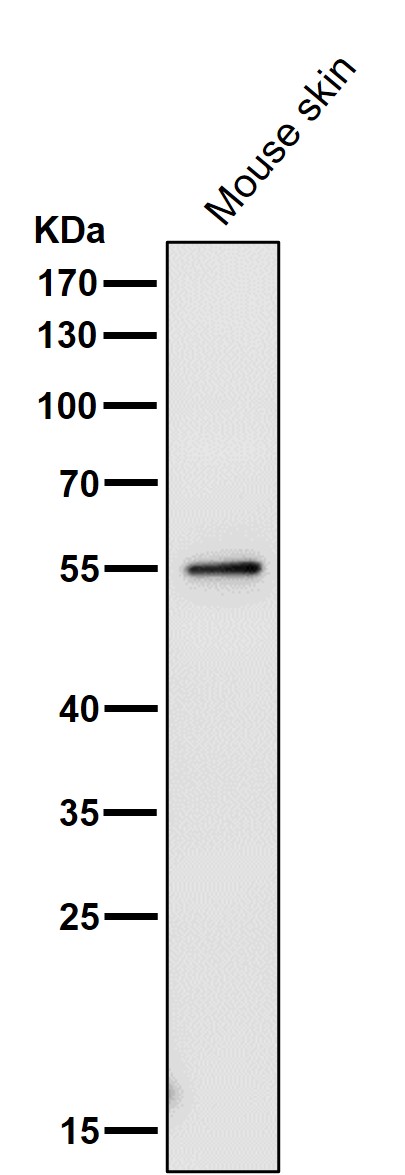


| WB | 1/1000-1/2000 | Human,Mouse,Rat |
| IF | 咨询技术 | Human,Mouse,Rat |
| IHC | IHC:1/100-1/200;IHF:1/50-1/200 | Human,Mouse,Rat |
| ICC | 1/50-1/200 | Human,Mouse,Rat |
| FCM | 1/20-1/100 | Human,Mouse,Rat |
| Elisa | 咨询技术 | Human,Mouse,Rat |
| Aliases | NMP200; nuclear matrix protein 200; pre-mRNA-processing factor 19; PRP19; PRP19/PSO4; PRPF19; PSO4; senescence evasion factor; SNEV; UBOX4;;PRPF19 |
| WB Predicted band size | 55 kDa |
| Host/Isotype | Rabbit IgG |
| Antibody Type | Primary antibody |
| Storage | Store at 4°C short term. Aliquot and store at -20°C long term. Avoid freeze/thaw cycles. |
| Species Reactivity | Human,Mouse,Rat |
| Immunogen | A synthesized peptide derived from human PRPF19 |
| Formulation | Purified antibody in PBS with 0.05% sodium azide,0.05% BSA and 50% glycerol. |
+ +
以下是3篇与PRP19抗体相关的代表性文献示例(仅供参考,具体文献需核实):
---
1. **文献名称**: "The human homolog of yeast Prp19 interacts with components of the spliceosomal U4/U6·U5 tri-snRNP complex"
**作者**: Makarov, E.M., et al.
**摘要**: 该研究利用PRP19抗体进行免疫沉淀实验,揭示PRP19在剪接体组装中的作用,证明其与U4/U6·U5 tri-snRNP复合物的相互作用,支持其在pre-mRNA剪接中的核心功能。
2. **文献名称**: "PRP19 transforms into a sensor of RPA-ssDNA after DNA damage and drives ATR activation via a ubiquitin-mediated circuitry"
**作者**: Zhang, X., et al.
**摘要**: 通过Western blot和免疫荧光技术使用PRP19抗体,研究发现DNA损伤后PRP19被招募至单链DNA区域,通过泛素化通路激活ATR信号,调控细胞周期检查点。
3. **文献名称**: "The ubiquitin ligase activity of PRP19 is essential for its role in pre-mRNA splicing"
**作者**: Mahajan, K.N., & Takeda, K.
**摘要**: 该文献利用PRP19抗体验证其泛素连接酶活性,证明该活性对剪接体功能不可或缺,为PRP19在RNA代谢与DNA修复中的双重作用提供机制解释。
---
**注**:以上文献信息为示例,实际引用时需通过PubMed或专业数据库(如DOI检索)确认准确性。如需具体文献DOI或发表年份,建议补充检索条件进一步筛选。
The PRP19 antibody targets the PRP19 protein (Precursor RNA Processing 19), a key component of the spliceosome involved in pre-mRNA splicing. PRP19. also known as PSO4 or NMP200. is a ubiquitin ligase critical for maintaining spliceosome stability during catalytic activation and disassembly. It forms the PRP19-associated complex (NTC, NineTeen Complex) with other proteins (e.g., CDC5L, SPF27), facilitating spliceosome remodeling and ensuring splicing fidelity. Beyond splicing, PRP19 participates in DNA damage repair, cell cycle regulation, and telomere maintenance, highlighting its multifunctional role.
PRP19 antibodies are widely used in molecular biology to study spliceosome dynamics, protein interactions, and subcellular localization. They are essential tools in Western blotting, immunoprecipitation, and immunofluorescence to investigate PRP19’s expression and function in diseases. Dysregulation of PRP19 is linked to cancer (e.g., overexpression in tumors), neurodegeneration, and developmental disorders, making it a potential therapeutic target. These antibodies often exhibit cross-reactivity across species (human, mouse, rat) and are available as monoclonal or polyclonal variants. Research utilizing PRP19 antibodies continues to unravel its dual roles in RNA processing and genome stability, advancing insights into disease mechanisms and RNA-targeted therapies.
×